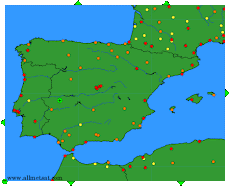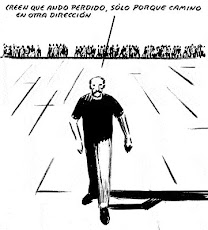miércoles, 17 de agosto de 2011
TERCER INFORME INTERINO DEL ACCIDENTE DEL AF447
Adjuntamos el tercer informe interino emitido por la BEA el pasado 29 de julio de 2011 en el que se recogen los últimos datos de la investigación del accidente del Airbus A-330 vuelo AF447, con origen en Río de Janeiro y destino en París-Charles de Gaulle.
En el siguiente enlace están disponibles los informes y notas de prensa emitidos por la BEA sobre el accidente del vuelo AF447.
Así mismo adjuntamos el resumen publicado en SKYbrary.
A332, en-route, Atlantic Ocean, 2009 (LOC HF AW WX
Description
On 1 June 2009, an Airbus A330-220 being operated by Air France on a scheduled passenger flight from Rio de Janeiro to Paris CDG at night and in IMC exited controlled flight and crashed into the sea with the loss of the aircraft and all 228 occupants.
Investigation
The Accident occurred over International Waters and is subject to Investigation by the French BEA as State of the Operator and State of the Manufacturer. Although some floating wreckage was discovered early in the extensive sea search which followed the disappearance of the aircraft, progress in the investigation was severely handicapped by inability to locate the remaining wreckage on the seabed and retrieve especially the FDR and CVR. Indications that erroneous airspeed indications had occurred were obtained from ACARS maintenance messages transmitted automatically at the time. The aircraft had not been in R/T communication with any ATC Unit at the time of loss and other aircraft in the vicinity heard no distress or other transmissions.
An Initial Interim Report was issued on 2 July 2009 and a second one on 17 December 2009.
After an extensive and carefully planned series of undersea searches, for which comprehensive details have been documented and published on the BEA website in English, the wreckage was found on the seabed at a depth of 3,900 m on 3 April 2011 in a position 6.5 nm north-north-east of the last position transmitted by the aircraft. Both the FDR and CVR were subsequently located and retrieved and despite the long period underwater, replay of both was successful. Some key findings were disclosed in a ‘Note’ published on 27 May 2011.
On 29 July 2011, the BEA published a Third Interim Report in the French language with the English translation following on 4 August. This Report contains full factual details and analysis based upon the data from the FDR and CVR and a review of the applicable Air France flight crew procedures and flight training. The ten Safety Recommendations made are reproduced verbatim near the end of this article.
The overall factual conclusion is that after a brief failure of two of the three airspeed indications whilst in the cruise which caused the autopilot to disconnect, the inappropriate response of the pilots put the aircraft into an aerodynamic stall from which, due to their confused state at the situation created, they did not take action to recover, so that the aircraft descended at a high rate out of control and impacted the sea surface. The BEA note that as the aircraft descended fully stalled, the stall warning "sounded uninterruptedly for 54 seconds...without provoking any appropriate reaction from the crew."
A short summary of the event sequence is presented below. It should be noted that, in common with most current civil aircraft types, there was no display of the angle of attack on the flight deck of the accident aircraft, although as always, this was tracked and used to provide stall warning and flight envelope protection which, when operative, makes it impossible to stall the aircraft.
At the time the sequence of events which led to the loss of the aircraft began, the aircraft commander, who had been operating as PM, had just commenced a routine rest period and his role and place in the left hand had been taken by the second First Officer. The other First Officer in the right hand seat remained as PF.
It was noted that “the Captain’s departure occurred without clear operational instructions” and that “there was no explicit task-sharing between the two co-pilots”.
Prior to the events which led to the eventual loss of the aircraft, all was proceeding routinely with the aircraft at FL350 and maintaining a speed of Mach 0.82 and a normal pitch attitude of about 2.5°.
On the basis of weather radar returns, the two First Officers decided to make a change of course to the left of 12°.
About two minutes later, while the aircraft was flying “at the upper limit of a slightly turbulent cloud layer”, “the autopilot then the auto thrust disengaged”.
This occurred because, in quick succession, two of the three airspeed indications, those on the left hand PFD and those on the ISIS (the Integrated Standby Instrument), failed. This is considered by the investigators to have been “a result of the obstruction of the Pitot probes in an ice crystal environment”.
Since the A330 is a Fly-By-Wire aircraft, a secondary effect of this was that the prevailing Control Law changed from 'Normal' to 'Alternate' which had the effect of removing automatic Flight Envelope Protection. Crew awareness of the change is confirmed by CVR recording of the PM acknowledging ‘alternate law protections’.
The immediate response of the PF was to make a significant nose-up input which led to the stall warning being triggered twice in a row. The Investigation notes that at the prevailing cruise speed and altitude, "the margin between the flight angle of attack and the angle of attack (at which) the stall warning (will be activated) is of the order of 1.5 degrees, but the stall warning speed displayed on the air speed tape (in alternate or direct law) will be around 40 kt below the actual speed".
In the presence of some roll instability, the pitch attitude of the aircraft “increased progressively beyond 10 degrees and the plane started to climb” with the vertical speed reaching 7000 fpm. There were no recorded comments from either pilot about this.
“The PF then made nose down inputs alternately to the right and to the left. The climb speed…..dropped to 700 ft/min” and the speed indications on the left PFD returned after an absence of 29 seconds showing Mach 0.68. “The airplane was then at an altitude of about 37,500 ft and the recorded angle of attack was around 4 degrees”
From this point, about 45 seconds after the disconnection of the autopilot, the PM made several attempts to call the Captain back to the flight deck.
39 seconds after the autopilot disconnection “…the stall warning triggered again. The thrust levers were placed in the TO/GA detent and the PF maintained his nose-up input. The recorded angle of attack, of the order of 6 degrees at the triggering of the stall warning, continued to increase. The trimmable horizontal stabiliser (THS) began moving and passed from 3 to 13 degrees nose-up in about 1 minute; it remained in this position until the end of the flight.” It is noted that these and subsequent THS movements were valid responses to pilot control inputs.
The Investigation notes that the approach to a fully stalled condition as a result of the pitch inputs of PF was correctly characterised by the triggering of the warning and then the appearance of buffet. A short time after the stall warning activated, the PF applied TO/GA thrust. It was noted that none of the pilots had made any reference to the stall warning or formally identified the stall situation.
In less than one minute after the disconnection of the autopilot, the aircraft became fully stalled and exited the AFM Flight Envelope as a result of the actions of the PF.
Until this happened, the aircraft longitudinal movements had been consistent with the position of the flight control surfaces.
Fifteen seconds after the continuous stall warning began, and after a failure lasting 54 seconds, the ISIS speed display returned and thereafter indicated the same as the other displayed speeds.
“The PF continued to make nose-up inputs. The airplane’s altitude reached its maximum of about 38,000 ft; its pitch attitude and its angle of attack were 16 degrees.”
At 51 seconds after the stall warning began (and 1 minute 30 seconds after the autopilot disconnection), the aircraft commander re-entered the flight deck and “in the following seconds, all of the recorded speeds became invalid and the stall warning stopped. This was because. if the angle of attack values become invalid, which they do by design below 60 kt CAS the stall warning becomes inoperative. This occurs because the airflow at the angle of attack sensors must be sufficient to ensure a valid measurement can be generated.
For the remainder of the flight, it was found that each time the stall warning had been intermittently triggered, the angle of attack had exceeded its theoretical trigger value.
The aircraft began to descend fully stalled. With the altitude "around 35,000 ft, the angle of attack exceeded 40 degrees and the vertical speed was around 10 000 ft/min. The airplane’s pitch attitude did not exceed 15 degrees and the engine N1 was close to 100%. The airplane was subject to roll oscillations that sometimes reached 40 degrees. The PF made a nose-up left input on the sidestick to the stop that lasted around 30 seconds.”
20 seconds after the Captain had re-entered the flight deck, the thrust levers were reduced to Flight Idle. As the aircraft continued to descend in a fully stalled condition, “the angle of attack, when it was valid, always remained above 35 degrees”
All recordings ceased 2 minutes 46 seconds after the Captain had re-entered the flight deck with a “pitch attitude of 16.2 degrees nose-up”
In beginning to examine the context for what happened and continuing to bear in mind the delays to the Investigation caused by the time taken to recover the data recorders, the Investigation:
Found that the PF had been an Air France pilot since 2004 and had been qualified on the Airbus A330 for six months. The PM had been an Air France pilot since 1999 and qualified on the Airbus A330 since 2002. It was noted that recent pilot training for "Unreliable IAS" had been carried out using a scenario just after take off, with circumstances which did not correspond to many of those which applied when the IAS displays temporarily failed on the accident flight. In addition, it was also noted that "the copilots had not been trained for manual airplane handling of approach to stall and stall recovery at high altitude" and that "no training was provided on the operation of the aircraft with two co pilots".
Concluded that a recording of the instrument panel to compliment the information provided by the FDR and the CVR would be useful because it would make it possible to confirm the indications that had been available to a flight crew as well as their actions, whether or not these produced recorded evidence. It is also considered that the present requirement to record only flight parameters displayed on the left hand side instrument panel was potentially unhelpful and that functional analysis of many complex systems on modern aircraft is “limited and delayed by the absence of a recording of all of the data sources that they use”.
Noted in respect of the airborne transmission of flight data, that “it is technically feasible to define reliable criteria based on flight parameters allowing emergency situations to be detected while limiting false alarms and it is technically feasible to obtain an impact position with enough precision, even in accidents where the airplane is in an unusual position”. It also noted that “in-flight activation of next generation emergency locator transmitters (ELT) using the same emergency detection criteria is feasible.”
Safety Recommendations
Six Recommendations relating to the task of accident investigation were included in the Second Interim Report, four in respect of flight recorders and two more in respect of aircraft certification:
- That EASA and ICAO extend as rapidly as possible to 90 days the regulatory transmission time for ULB’s installed on flight recorders on airplanes performing public transport flights over maritime areas'
- That EASA and ICAO make it mandatory, as rapidly as possible, for airplanes performing public transport flights over maritime areas to be equipped with an additional ULB capable of transmitting on a frequency (for example between 8.5 kHz and 9.5 kHz) and for a duration adapted to the pre-localisation of wreckage;
- That EASA and ICAO study the possibility of making it mandatory for airplanes performing public transport flights to regularly transmit basic flight parameters (for example position, altitude, speed, heading).
- That ICAO ask the FLIRECP group to establish proposals on the conditions for implementing deployable recorders of the EUROCAE ED-112 type for airplanes performing public transport flights.
- That EASA undertake studies to determine with appropriate precision the composition of cloud masses at high altitude
- That EASA, in coordination with the other regulatory authorities, based on the results obtained, modify the certification criteria (in respect of the effects of cloud masses at high altitude)
The Third Interim Report contains ten further Recommendations, three relating to pilot training and procedures following an examination of those in place at Air France, one in respect of data presentation to the pilots and six more concerning accident investigation issues:
- That EASA review the content of check and training programmes and make mandatory, in particular, the setting up of specific and regular exercises dedicated to manual aircraft handling of approach to stall and stall recovery, including at high altitude.
- That EASA define additional criteria for access to the role of relief Captain so as to ensure better task-sharing in case of relief crews.
- That, provisionally, the DGAC define additional criteria for access to the role of relief Captain so as to ensure better task-sharing in case of relief crews.
- That EASA and the FAA evaluate the relevance of requiring the presence of an angle of attack indicator directly accessible to pilots on board airplanes.
- That ICAO require that aircraft undertaking public transport flights with passengers be equipped with an image recorder that makes it possible to observe the whole of the instrument panel.
- That at the same time, ICAO establish very strict rules for the readout of such (image) recordings in order to guarantee the confidentiality of the recordings.
- That EASA and the FAA make mandatory the recording of:
the position of the flight director crossbars,
the parameters relating to the conduct of the flight displayed on the right side, in addition to those displayed on the left side.
- That EASA and the FAA evaluate the relevance of making mandatory the recording of the air data and inertial parameters of all of the sources used by the systems.
- That EASA and ICAO make mandatory as quickly as possible, for airplanes making public transport flights with passengers over maritime or remote areas, triggering of data transmission to facilitate localisation as soon as an emergency situation is detected on board;
- That EASA and ICAO study the possibility of making mandatory, for airplanes making public transport flights with passengers over maritime or remote areas, the activation of the emergency locator transmitter (ELT), as soon as an emergency situation is detected on board
During the presentation of the Third Interim Report, the BEA advised that the remainder of the Investigation will focus particularly on the Human Factors aspects of the accident and that a new Working Group within the investigation has been established to progress this whilst the already-existing Airplane Systems Working Group progresses the pitot icing issue.
The BEA stated on 3 August that the Final Report of the Investigation is expected to be published during the first half of 2012.
Suscribirse a:
Comentarios (Atom)














